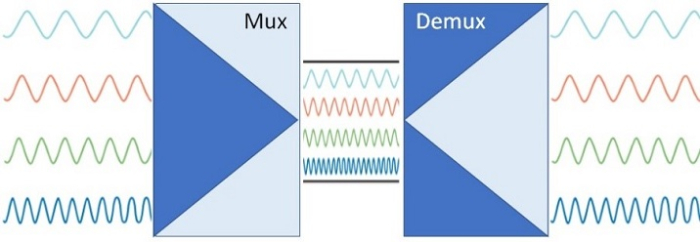
 Data Structure
Data Structure Networking
Networking RDBMS
RDBMS Operating System
Operating System Java
Java MS Excel
MS Excel iOS
iOS HTML
HTML CSS
CSS Android
Android Python
Python C Programming
C Programming C++
C++ C#
C# MongoDB
MongoDB MySQL
MySQL Javascript
Javascript PHP
PHP
- Selected Reading
- UPSC IAS Exams Notes
- Developer's Best Practices
- Questions and Answers
- Effective Resume Writing
- HR Interview Questions
- Computer Glossary
- Who is Who
Difference between Baseband and Broadband Transmission
Data transmission has been crucial in the age of digital communication. Either digital or analogue data can be transmitted over a communication medium to one or more devices, depending on the interfaces in use. There are two important types of data transmission ? Baseband and Broadband.
Read through this article to understand each type of transmission and the differences between them.
What is Baseband Transmission?
It is a transmission technology where a single signal is either sent or received through a communication channel such as a cable, in the form of discrete pulses of the single frequency.
The frequency of the baseband signal is not altered. The signal bandwidth is almost zero. As there is no frequency shifting in baseband systems, only one signal occupies the entire bandwidth of the system at a time. Any remaining bandwidth is therefore wasted.
In this technology, multiple devices connected in a network communicate with each other by transmitting and receiving data on a single communication channel, which is shared among multiple devices using its entire bandwidth. Either transmission or reception of data takes place at a time. The signal needs to be of one common type which is ?understandable' by all the devices in the network. The same medium however can be shared using Time Division Multiplexing (TDM).
Ethernet-based wired Local Area Network (LAN) is a popular application of baseband signal. The following image depicts transmission of Baseband signal ?

Advantages of Baseband Transmission
Here are some advantages of Baseband Transmission ?
Simple in implementation.
Costs incurred for installation are low.
Overall maintenance costs are lesser than Broadband transmission costs.
Disadvantages of Baseband Transmission
Following are the disadvantages of Baseband Transmission ?
It can be used for transmission of only data and voice.
It works good only for short distance.
Coverage of the signal is limited.
What is Broadband Transmission?
It is a transmission technology where multiple signals of different frequencies are simultaneously sent through a single communication channel.
At the transmitting end, entire bandwidth is logically divided into multiple signals using a multiplexing device. These multiple signals are sent over the communication channel such as Radio Waves or Optical Fiber. At the receiving end, the signals are accumulated into one single signal using a demultiplexer device. Large files, audio, and video are transmitted on broadband with high speed at long distances.
The following image depicts how broadband signal transmission takes place ?

Signals with different frequencies are taken by a Multiplexing device, transmitted over the medium as one logical signal and then divided back to multiple signals.
Types of Broadband Technologies
Six main types of broadband technologies are ?
Digital Subscriber Line (DSL) ? In this type, the telephone wires are used for accessing Internet. The DSL Modem is required to set-up the Internet connection. The Internet Service Provider (ISP) sends the signal through phone line to the DSL modem. The modem receives signal and converts it to the signal you need to use the Internet.
Cable Modem ? In this type, the cable television infrastructure is used to access the Internet. It comprises of a modem inside user's place and a coaxial wire or cable that runs from the modem to the Cable Modem Termination System (CMTS) located in the premises of the ISP. Simply, it works by connecting the modem to the CMTS using a coaxial cable.
Optical Fiber ? In this type, fiber-optic cable is used for data transmission, which can transmit data at a phenomenal speed of 70% the speed of light. Fiber-optic cables are also tough on weather, and they reduce maintenance costs.
Wireless ? As the name depicts, there are no physical wired involved for data traffic. Data is sent over radio waves. It requires a wireless Internet modem, a wireless access card or Internet dongle, and a Wireless Internet Connection Provider (WISP) service. This technology is weather-dependent hence slower.
Satellite ? A satellite dish is required to be installed on which the data is projected from the space via the satellite orbiting around the Earth. It provides wide reachability even in the remote places of the country.
Broadband over Power Lines (BPL) ? In this technology of transmission, overhead and underground power lines are used to carry broadband data for long distances.
Advantages of Broadband Transmission
Data transmission is fast.
The transmission can take place for long distances.
Large bandwidth provision for transmission.
Disadvantages of Broadband Transmission
Additional hardware such as Multiplexers and De-multiplexers are required.
High cost of implementation and maintenance is high.
Differences between Baseband and Broadband Transmission
The following table highlights the major differences between Baseband and Broadband technologies ?
| Key Factor | Baseband | Broadband |
|---|---|---|
| Type of Signal | Digital signal is transmitted in the form of frames or packets. | Analog signal is transmitted in the form of waves. |
| Number of Channels involved | The same channel is used for transmitting and receiving data. | Two channels are used ? one for transmission and the other for reception of data. |
| Direction of Transmission | Bidirectional | Unidirectional |
| Structure | Simple, no special hardware is required to implement. | Complex due to the need of unique hardware. |
| Distance Covered | Signal can travel to its best only for short distances such as a couple of miles. For long distance baseband signal, attenuation is needed. | Signal can travel long distances without having to be attenuated. |
| Medium of Transfer | Copper cables, twisted-pair coaxial cables, and wires. | Optical fibers, coaxial cables, and radio waves. |
| Topology | It works best when the nodes in the network are arranged in Bus topology. | It works best in Bus and Tree topologies. |
| Expenditure | Inexpensive to implement. | Design and implementation of transmission is expensive. |
| Type of Multiplexing Support | Supports Time Division Multiplexing (TDM), where all the signals are transmitted at the same frequency at different times. | Frequency Division Multiplexing (FDM), where all signals are transmitted at different frequencies. |
Conclusion
Having seen the two types of transmission, Baseband and Broadband, we now understand the differences between them. Baseband is a low cost, simple, and uni-channel data transmission where only one channel is involved in transmission as well as reception of data. It supports short distance signal coverage. On the other hand, Broadband transmission offers multichannel, high speed transmission through a single medium, which can reach out to very long distance.

